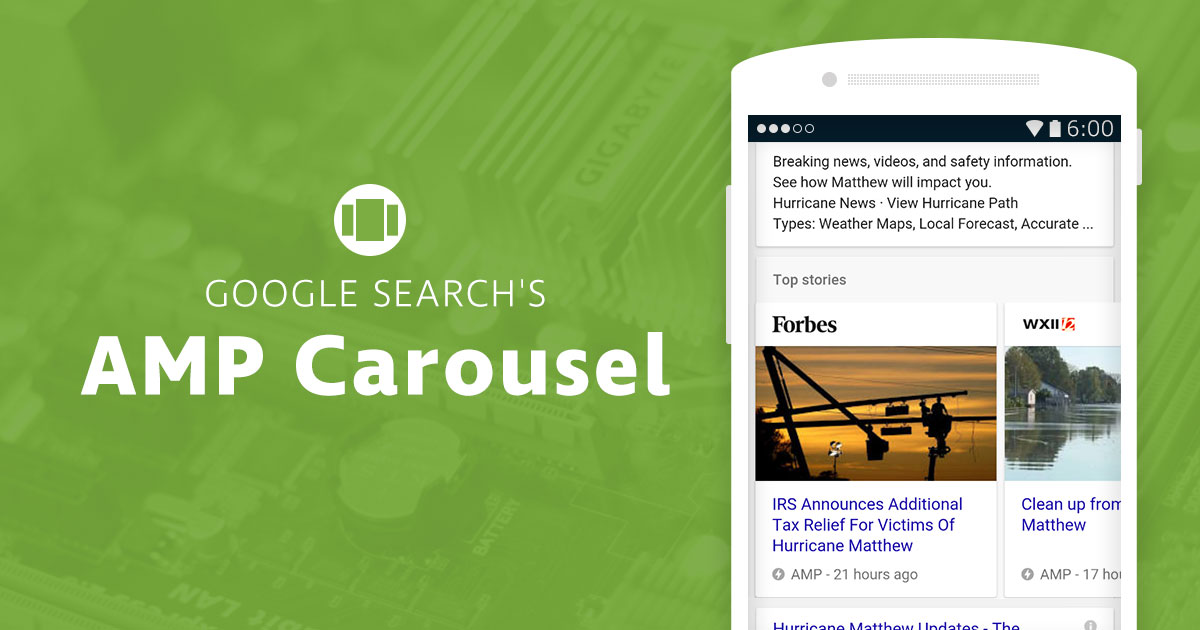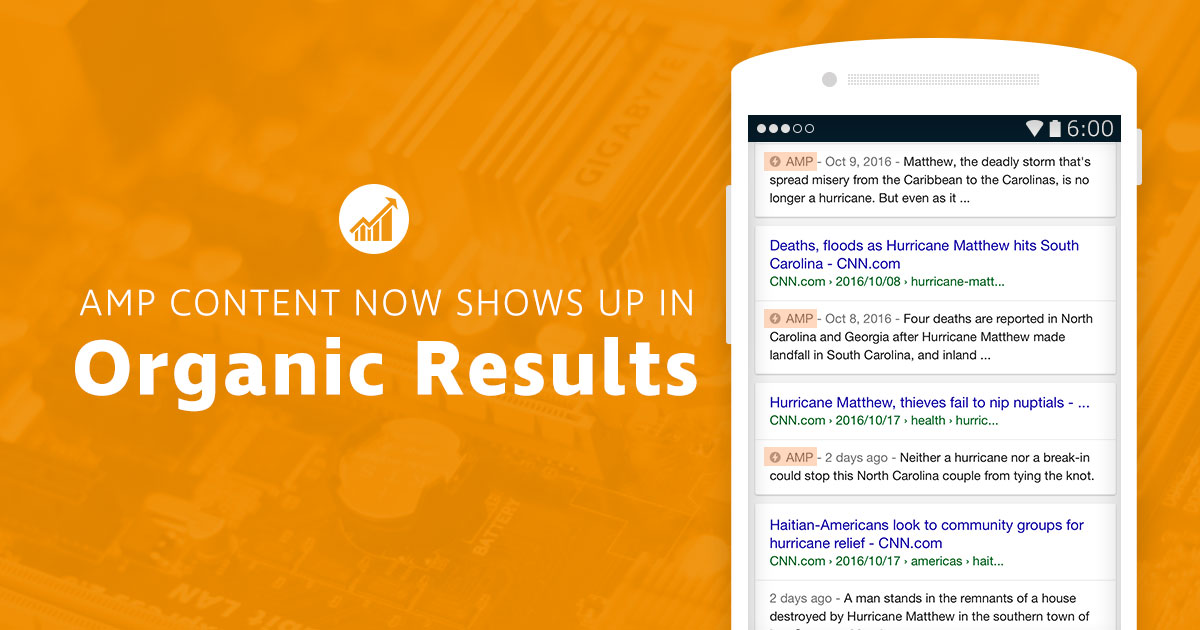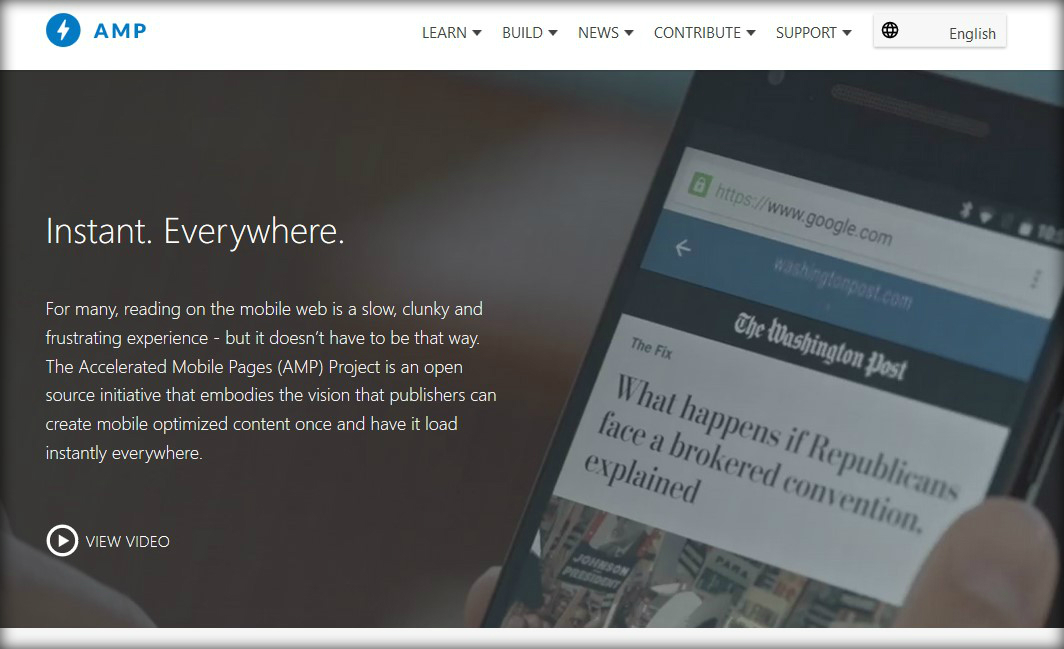Accelerated mobile pages – called AMPs – are one of Google’s newest projects. Google’s techies created the platform to help web publishers provide content to users that loads quickly across mobile devices.
Presently, the platform maintains a large focus on news stories. In a blog post that preceded the AMP launch, Google explained the project’s original intent: Rich content, such as video animations and graphics, should work alongside smart ads and load instantly.
With the open-source AMP platform, Google hopes to consistently deliver the best experience for its mobile search users. Our culture has been trained to look for instant gratification, and Google knows that we need lightning fast, accurate information.
How AMP Content in Google Mobile Search Works
AMP content officially debuted in Google mobile search in February 2016. These articles were easy to distinguish from other formats: They appear in a “carousel” layout, allowing users to swipe horizontally between the best results. Each entry also features a lightning bolt icon and the acronym “AMP.” Users have already enjoyed the fast results, prompting more research into the platform’s possibilities.
The AMP framework coincides with existing HTML coding but allows publishers to create lightweight webpages – pages that are simpler and faster because they use fewer parts. The entire project is essentially just a set of specifications, both requirements and restrictions, powered by JavaScript (although publishers cannot write their own JavaScript). CSS3 is used for customized styling, and every page is cached on Google’s servers, working like a content delivery network.
So how much faster are AMPs? With advanced coding, the median load time is a mere 0.7 seconds, according to SearchEngineLand.com. That’s incredibly quick, especially when you compare it to all other pages on the web with non-AMP coding – which average 22 seconds.
How AMP Content Is Moving Across Industries
Although similar, AMPs are quite different from traditional webpages. If website happens to offer different versions of a particular page (such as desktop, mobile and AMP versions) for different devices, your mobile search engine will always prefer the AMP material. This could be the future of instantaneous search results, and the platform’s reach is widening.
In the beginning, AMP specifically catered to news stories. It’s already transitioning, though, opening up to new companies and industries daily. Take eBay, for example. The online auction site has deployed an AMP-powered shopping experience for mobile users since June 30. It has more than 8 million queries, known as “browse nodes,” already available or in production. AMP results can be a vital part of almost any company’s marketing strategy.
Not only is the AMP platform opening up to new industries, but other search engines are beginning to subscribe as well. Just last month, Microsoft announced that Bing has joined the open-source effort, and that it plans to treat AMP content similar to how Google indexes and features it. This means that the platform has spread well beyond Google, and that the potential reach of AMP content is only going to continue to grow.
Google Is Pushing for AMP Growth
AMPs are a game-changer, especially considering that most internet searches are now done on a mobile device more often than on desktop and laptop computers. Always at the forefront of change, Google has been working hard to increase traffic to AMP pages.
The links to AMPs look identical to others, aside from the lightning bolt logo and “AMP” label tucked along the bottom. The carousel also remains, although it’s currently unclear whether Google has plans to remove it entirely and fully combine AMP results.
In recent news, Google has started integrating AMP content into the organic mobile search results, in addition to still offering the “Top stories” carousel of AMP-only content. The AMP logo is clearly visible now in the organic search results, right where the “Mobile-friendly” label used to be – ahead of the meta description for a particular entry.
AMP Results Now Outweigh Indexed App Content
In 2013, Google began indexing content from apps, and it generally only shows up to users who already have that particular app installed. What this means is that if you conduct a search and Google finds that you already have an app that has your answer, then you would see that content show up in your mobile search results. And if you click on that result, the search engine will take you straight to your app, rather than a webpage.
While Google is still indexing app content, its mobile search engine is now favoring AMP material over “app deep links.” Google’s head of global products partnerships, Adam Greenberg, made this revelation at the SMX East conference in New York last month.
This update shows how deeply committed Google is to the AMP platform for now and the near future. The change might leave some app developers frustrated, but nonetheless, publishers need to adjust their focus to AMPs – rather than worrying about getting app content to rank in mobile search.
Will AMP Content Help Your Website Rank Better?
As of now, Google has no plans to make AMP material a ranking factor for websites. In other words, offering AMP content won’t necessarily give your entire website’s search rankings a boost.
However, Google almost always gives AMP content page one treatment when someone uses conducts a search via mobile. So producing AMP content may be a way to boost awareness of your website, especially if you’re having trouble cracking that first page organically.
Although it may seem a bit exclusive at the moment, the goal of the AMP project is to produce efficient and fast internet content. Richard Gingras, head of news and social products for Google, told the Nieman Journalism Lab that the AMP launch is a step forward for the technological ecosystem, with a shift toward better content performance.
Why the Search Engine Change Matters
Interestingly, AMPs are hosted on their own servers when visited from a Google search. This means using the AMP platform is a bit of a give and take. You’ll receive special treatment in the form of high search results and mass availability. However, the links point to Google, or whichever search engine someone used to find your AMP content.
This a significant change from the way Google has worked in the past. Previously, the web giant was simply an index that directed visitors to other sites. Now, AMPs can keep visitors exclusively on Google properties. Companies will need to ask themselves if they’re ready for higher visibility with little to no significant increase in actual traffic.
AMPs Are Like Instant Articles – Only Better
The AMP platform is comparable to Facebook’s Instant Articles, which gives content publishers the option to embed data onto the social network. When publishers utilize Instant Articles, followers can consume content without having to leave Facebook’s app.
Many are viewing the AMP project as a vast improvement over Instant Articles, since AMPs provide more opportunities to lead users to your full website.
What About Ads in AMP Content?

The AMP project vets analytic information by special criteria, including performance, privacy and security. Publishers can choose to use the AMP tag, similar to the traditional tag. Sections of JavaScript can be placed on the website, although it won’t include access to the same amount of data.
Taking Advantage of the AMP Platform

If your team includes a web designer (or if you have some coding background yourself), it’s easy to design a custom AMP page from scratch. The project’s homepage (see screenshot below) includes a huge selection of resources too, which will help you learn how to create the content on your own. You’ll also find a technical section to learn more about how AMP works, plus code samples, source code and documentation courtesy of GitHub.
The AMP platform in continuously growing and changing, and it’s in the news almost weekly. At Eminent SEO, we’ve been following the AMP developments closely. It might seem like a lot to take in, but we can help. If you want to understand more about Accelerated Mobile Pages, what they can do for your business, and how to optimize them, trust our expertise to guide you. Call 800.871.4130 for help with building AMP pages today!







